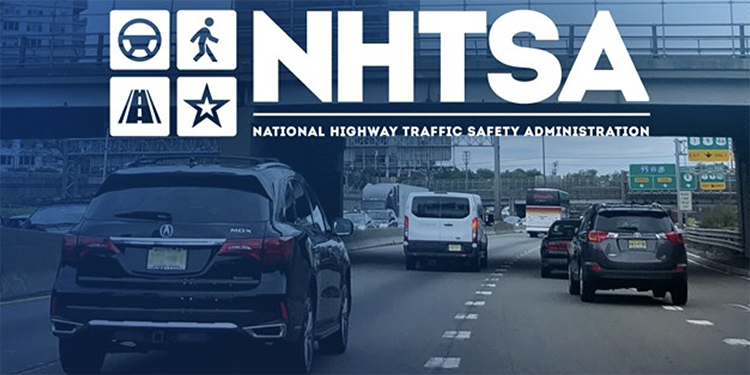Tire Pressure Monitoring Systems
Installing one of these safety devices can help to prevent tire emergencies while on the road.
By Mark Quasius, F333630
June 2023
A tire pressure monitoring system (TPMS) is a popular accessory for RV owners, but it’s more than that. It’s a safety item, much like a fire extinguisher, that should be present on any RV. While late-model vehicles used to tow RVs generally are equipped with an on-board TPMS, the devices rarely are capable of monitoring the RV. Some motorized RVs also are equipped with a TPMS, but it most likely won’t be able to monitor a towed vehicle. Fortunately, numerous aftermarket systems can monitor the tires on any combination of vehicles.
WHAT IS A TPMS?
A TPMS is simply a monitor that communicates remotely with sensors located on each wheel. Displays are offered in many forms, depending on the manufacturer of the system. They are all capable of displaying the tire pressures at each wheel location and issuing an audible and visual warning should the inflation pressure drop below the preset level. The display may be equipped with a small rubber antenna or a coaxial connection that can be linked to one or more remote antennas to better communicate when the axles are farther apart, as on large RV configurations. In some cases, a motorhome may be equipped with a built-in TPMS. A bridge device will replace the display that comes with the aftermarket TPMS and allow tire pressure information to be communicated directly to the coach’s on-board display via the RV-C network bus.
The sensors can be mounted internally to the tire or mounted externally when threaded onto the valve stems. Some sensors are capable of monitoring only the tire’s inflation pressure, while others can simultaneously monitor pressure and temperature. Some internal sensors replace the tire valve stems as part of the sensor. This method is used on virtually all passenger cars and light trucks made today. If your sensors do not replace the valve stem, they are most likely fastened to the inside of the wheel rim with large worm-drive clamps. This is a plus if you want to retain the factory sensors for normal driving and just use the RV sensors when towing.
External sensors mount on the valve stems and replace the valve stem caps. Rigid valve stems are recommended, because the added weight of the external sensor and the centrifugal force created when the wheel is spinning will cause a rubber valve stem to flex and leak, followed by an eventual failure of the valve stem. External sensors also can be stolen, or knocked off if you have a vehicle that you like to take off-roading; internal sensors are theft-proof and a better choice for off-road use. If you do use external sensors, it’s a good idea to put a light film of Permatex antiseize lubricant on the threads to prevent corrosion that would make the sensor difficult to remove later.
The sensors operate in the 433 MHz band, but you shouldn’t have any conflicts running multiple systems, because the TPMS won’t interfere with the vehicle’s OEM system. If your motorhome is equipped with a factory TPMS that services the coach, you can always just get a simple third-party system to monitor your towed vehicle if you don’t want a system that monitors both vehicles.
DO I REALLY NEED A TPMS?
Prior to the availability of tire pressure monitoring systems, RV owners simply checked the tires every morning before departure with a tire pressure gauge. Truckers used to thump each tire with a tire club or a hammer. While the latter was not very accurate, it would at least let you know if one of the tires on a dual-wheel setup was flat or about to go flat.
Even if using an accurate tire pressure gauge in the morning, the only information that provides is the tire pressure at that point in time. If a tire begins to lose inflation pressure while you are driving, you won’t know if something is amiss and a tire failure is imminent.
Tires need to be inflated to their specified air pressure to safely carry the load placed on them. If tires are run at a pressure beneath the minimum requirement for that load rating, the tire will overheat and stress. If this condition is allowed to continue, the tire will fail, and you may experience a life-changing (or life-ending) blowout. A TPMS will monitor the tire pressure while you drive and give you adequate warning if a tire begins to lose pressure.
However, a TPMS won’t give you 100 percent protection. If you drive over something that causes the tire to develop a slow leak, the TPMS will notify you before it deflates. But if you have an instantaneous rapid loss of pressure due to a sudden catastrophic tire failure, the TPMS won’t be able to give you any warning. The majority of tire failures are not that sudden, so the TPMS will be able to alert you in most situations.
As noted, some tire pressure monitoring systems also can monitor tire temperature. Tires can fail if they overheat, which can be caused by numerous factors. A tire inflated below the required minimum inflation pressure for that weight will overheat. Excessive heat also can be caused by a failing wheel bearing, a sticky brake pad, or an alignment issue that’s likely the result of a worn suspension component.
Tires are cured in molds higher than 200 degrees Fahrenheit and are then cooled down to retain their form. If your tire ever reaches anywhere close to 200 degrees while driving, it will go into reversion and soften to the point where it will fail. Most tire pressure monitoring systems that keep track of temperature will warn you if the tire’s temperature reaches 175 degrees. I’ve personally experienced that while towing our Jeep behind our motorhome. The breakaway valve on our supplemental braking system started to leak, causing the brakes on the Jeep to drag, which increased the tire temperatures in the Jeep’s rear axle. My TPMS sounded an alarm and showed me that the Jeep’s tires were getting hot, so I pulled over, repaired the Jeep’s breakaway valve, and cooled the brakes down with water from the RV to correct the problem before any serious damage occurred.
Aftermarket TPMS Suppliers
Following is a summary of some popular systems offered by aftermarket suppliers
*FMCA commercial member.
Advantage PressurePro LLC
(800) 959-3505 | www.pressurepro.us
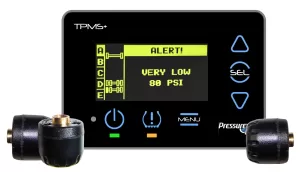
Advantage PressurePro: Pulse
Pulse
Sensors: External; can monitor up to five vehicles and up to 80 wheel positions.
Transmitter Batteries: Nonreplaceable; life expectancy is five years. Components are sealed for protection from all environments and to reduce the possibility of sensor failure from overtightening or not being tight enough.
Screen Display: 4.5-inch (diagonal) color OLED display.
Alerts For: Five alerts, including low and high pressure and high temperature, as well as cross axle.
Pressure Range: 8 psi to 215 psi.
Other Features: The unit can be plugged in or powered by a hardwired cord via either a 12-volt or a 24-volt system. Built-in data-logging capabilities offer up to 45 days of temperature and pressure history with PressurePro’s free management software via RS232, which also allows tethering to other RS232 devices. Changing setups or switching between different towed vehicles is a two-button operation. Alerts and configurations can be customized by the user.
MSRP: Approximately $600 for a four-wheel unit; additional sensors $100 per pair.
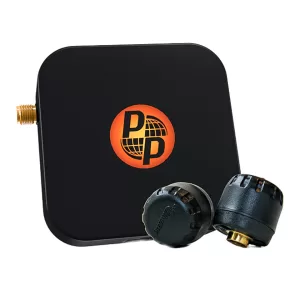
Advantage PressurePro: Pulse FX
Pulse FX
Sensors: External; can monitor up to five vehicles and up to 80 wheel positions.
Transmitter Batteries: Nonreplaceable; see Pulse battery info to the left.
Screen Display: Utilizes a smart device.
Alerts For: Five alerts, including low and high pressure and high temperature, as well as cross axle.
Pressure Range: 8 psi to 200 psi.
Other Features: Designed originally for towables, the Pulse FX also can be used with motorhomes. It utilizes Android and iOS smartphones or tablets. It’s useful for a towing vehicle that switches between a towable RV and a boat trailer or other towed vehicle; the system has multiple memory profiles and names for every trailer. A Bluetooth unit plugs into a 12-volt power outlet and has a remote antenna, which usually is cabled to the rearview mirror area. The unit can be plugged in or powered by a hardwired cord via either a 12-volt or a 24-volt system. Alerts and configurations can be customized by the user.
MSRP: $450 for a four-wheel system; additional sensors $100 per pair.

EEZ RV Products: EezTire
EEZ RV Products LLC, C11163*
(928) 317-8899 | www.eezrvproducts.com
EezTire
Sensors: External; can monitor up to two vehicles and up to 26 wheel positions; antitheft design; standard and flow-through sensors are available.
Transmitter Batteries: CR1632; life expectancy up to two years; replaceable by the owner.
Screen Display: 4.5-inch (diagonal) color with a built-in rechargeable lithium battery. A hardwired cable is included.
Alerts For: Pressure and temperature.
Pressure Range: Up to 210 psi.
Other Features: A booster/repeater is available to overcome electronic interference and distance challenges. The towed vehicle can be dropped from the system and picked back up when connected. The system transmits pressure and temperature information to the monitor at 6-second intervals.
MSRP: Systems range from $299 to $1,139.
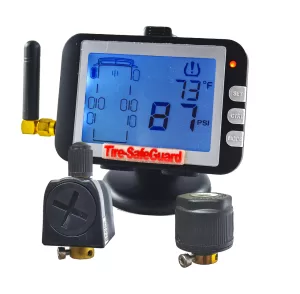
Intelligent Vehicle Products: Tire-SafeGuard
Intelligent Vehicle Products
(818) 400-9976 | www.tiresafeguard.com
Tire-SafeGuard
Sensors: Internal rim-mounted, internal valve-mounted, external cap, and external flow-through sensors are available. Can monitor up to 20 wheel positions. The external sensors have antitheft locking screws.
Transmitter Batteries: External sensors are owner replaceable; internal sensors are not owner replaceable.
Screen Display: 2.5-inch black-and-white LCD with a rechargeable battery and a power cord jack for external power or battery recharging tasks.
Alerts For: Pressure and temperature.
Pressure Range: 0 psi to 199 psi.
Other Features: The user can take the monitor along when refilling air and see the current pressure readings from the screen.
MSRP: $279 for a six-tire system; $479 for a 10-tire system. Other systems also available.
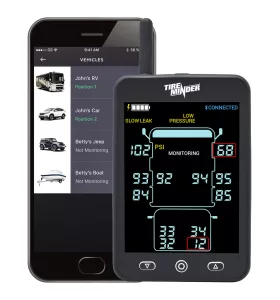
Minder Research: TireMinder AIAS
Minder Research Inc., C12082*
(777) 463-6522 | www.minderresearch.com
TireMinder A1AS
Sensors: External; can monitor two vehicles and up to 22 wheel positions; sensors are secured with Allen-screw antitheft locking rings. Flow-through sensors are also available.
Transmitter Batteries: CR1623; life expectancy is one year. Replaceable by the owner.
Screen Display: 5.5-inch (diagonal) color LCD and Bluetooth to smartphone app.
Alerts For: Pressure and temperature.
Pressure Range: 0 psi to 199 psi.
Other Features: Checks for tire problems every six seconds and instantly warns of unstable conditions. Sensor reading updates occur every four minutes. A temporary disconnect mode separates a towing vehicle from a towed vehicle. The kit includes a signal booster.
MSRP: $529 for a four-wheel system; $579 for a six-wheel system.
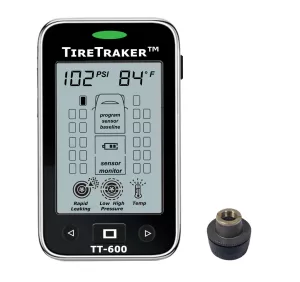
RV Safety Accessories: TireTraker TT-600
RV Safety Accessories Inc.
(866) 200-9773 | www.tiretraker.com
TireTraker TT-600
Sensors: External; can monitor up to two vehicles and up to 22 wheel positions.
Transmitter Batteries: CR1632; replaceable by the owner.
Screen Display: 4-inch (diagonal) black-and-white LCD display with a built-in antenna. The monitor’s rechargeable battery holds a charge for up to 30 days; a dedicated micro-USB-compatible charger is included.
Alerts For: Pressure and temperature.
Pressure Range: 0 psi to 232 psi.
Other Features: The system goes into sleep mode after 15 minutes with no motion to conserve battery life. All systems include the new high-power TT-200 signal booster. TireTraker has a lifetime warranty.
MSRP: Ranges from $199 to $829. A four-wheel system is $199; a six-wheel system is $269; a 10-wheel system is $409.
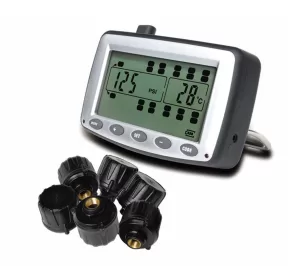
Tire-Protector
Tire-Protector, C1238*
(800) 659-6339 | www.tireprotectorusa.com
Tire-Protector
Sensors: External cap-style or external flow-through; antitheft locking collar; can monitor up to 22 wheel positions.
Transmitter Batteries: CR1632; replaceable by the owner.
Screen Display: 3.75-inch (diagonal) black-and-white LCD.
Alerts For: Pressure and temperature.
Pressure Range: 8 psi to 188 psi.
Other Features: The sensors detect tire pressure and temperature readings every three to five seconds and transmit data to the monitor. A loss of pressure or rise in temperature immediately triggers an alert; the monitor can be placed in the towed car when it is driven.
MSRP: $440 for a six-wheel system; $490 for a 10-wheel system.
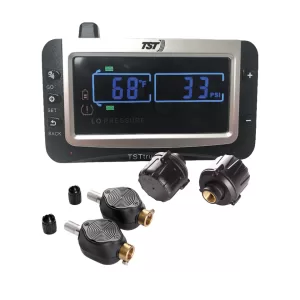
Truck System Technologies: 507 Series
Truck System Technologies Inc., C12907*
(770) 889-9102 | www.tsttruck.com
507 Series
Sensors: Internal, external, cap, and flow-through sensors are available; can monitor up to 115 wheel positions, including a towing vehicle and four trailers or towed vehicles; theft-resistant.
Transmitter Batteries: Sealed lithium-ion (for internal sensors); CR1632 or CR2032 (for the RV cap and flow-through sensors) are replaceable by the owner.
Screen Display: 3.5-inch (diagonal) full- or one-color display powered by a rechargeable lithium-ion battery; power also can be provided by a cord to a USB or a 12-volt receptacle.
Alerts For: Pressure and temperature.
Pressure Range: 1 psi to 218 psi.
Other Features: The unit has a built-in antenna; a remote extender (included) expands the operating range. A trailer or towed vehicle can be removed temporarily from the display when they are not being towed.
MSRP: The TST-507-FT-4-C (a four-tire flow-through cap system with color display) is $432. Other kits range from $333 to $975.
The post Tire Pressure Monitoring Systems appeared first on Family RVing Magazine.
Source: https://familyrvingmag.com/2023/06/01/tire-pressure-monitoring-systems-2/


